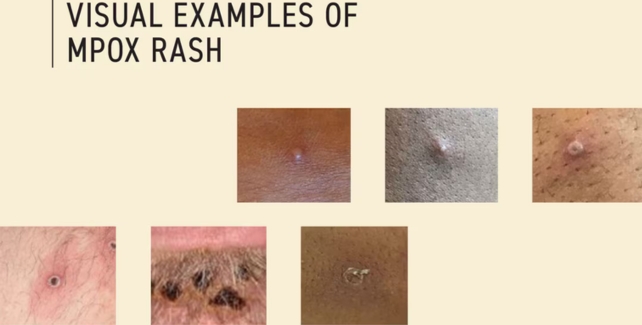The new strain of the MPOX virus is spreading rapidly along the eastern border of the Democratic Republic of the Congo and is “the most dangerous yet,” according to the World Health Organization. The current outbreak is due to sexual transmission, but there is evidence that this strain can also be transmitted through close skin-to-skin contact. Those currently infected include schoolchildren, health workers and entire households.
In South Africa, an outbreak has already claimed three lives. Border authorities are screening travelers entering and leaving the country.
Virologist Cheryl Walter explains the history of MPOX, the symptoms and why we should be concerned about virulent viral mutations.
What are the symptoms?
Symptoms of MPOX start out quite vague: fatigue, body aches, fever, headache, respiratory symptoms, and rash.
The rash symptom is a useful element in differentiating from other common viral diseases. In the case of COPD, the rash can be itchy and painful and quickly develop into fluid-filled blisters that then crust over.
The fluid in these blisters is infectious, and COPD can be spread by sharing towels or toothbrushes, for example. Some people only have a few blisters, and they may be hard to see, depending on where they are on the body. And some people have no symptoms at all.
Although treatment of MPOX is primarily symptomatic (rest, hydration, and pain relief), people hospitalized with severe MPOX may be treated with broad-spectrum antivirals and monitored more closely.

What is worrying about recent epidemics?
By genetically analyzing old samples from MPOX patients, we now know that the MPOX epidemic began to grow in Nigeria around 2016. As more people became ill with MPOX, the epidemic spread to other African countries, spread outside Africa, and has since been detected in 116 countries.
In July 2022, the WHO declared MPOX a public health emergency of international concern. At the time of writing, a total of 97,745 people had been infected and 203 people had died since the outbreak began, with most cases confirmed to be less severe clade II variants.
Since then, some disturbing observations and discoveries have been made about this increase in MPOX cases.
First, MPOX now spreads easily from person to person, although scientists aren’t sure exactly why.
Second, because of this sustained transmission, mutation is also faster and two subclades (side branches) called clades Ib and IIb have been discovered.
Third, there is no licensed vaccine specific to MPOX to prevent infection, nor are there specific antiviral drugs available to treat clinically vulnerable people who can become very ill and die from the virus.
What is mpox?
Mpox, formerly known as monkeypox, is a smallpox virus that was first identified in Denmark in laboratory monkeys exported from Africa in the 1950s.
At first, it was probably thought to be a smallpox virus that only infected monkeys, but the first human cases were documented in the Democratic Republic of Congo in the 1970s. The cases were caused by small animals, such as monkeys and small rodents, that transmitted the disease to humans. So the name stuck. This virus didn’t get much attention until recently.
The name was changed to combat any stigma associated with it, but also to highlight the evolution of this virus over 50 years of confirmed human cases.
Mpox is related to other smallpox viruses, including vaccinia and, most notably, the now-eradicated variola. It is not related to the very common chickenpox virus, although many of the symptoms of the infection are the same.
Genetically, mpox viruses fall into two main branches called clade I and clade II. Clade I virus infections are associated with a high mortality rate, up to 10%. Clade II, which has a much wider geographic distribution and covers West Africa, is associated with a much lower mortality rate of 1%.
Clade I viruses are more common in the Democratic Republic of Congo and are much less common in samples than clade II viruses. Both are transmitted in the same way: through close physical contact between humans, including sexual contact.
Although animal-to-human transmission can occur, recent health messages have focused on high-risk groups such as sex workers and men who have sex with men, two groups that have been disproportionately affected by the recent outbreak.
Anyone with symptoms of MPOX infection – or who has had close, not necessarily sexual, contact with a confirmed case – should be tested.

What’s next for mpox?
First, there is a need for health agencies to improve their communication about the types of transmission that can occur between people, where to get tested, and how at-risk groups can be better protected. Drawing on lessons learned from the HIV/AIDS crisis, we must do more to demystify MPOX and all the misconceptions about it.
Second, a tailored vaccine is needed to protect against new infections. An mRNA vaccine candidate is already in clinical trials.
Better drugs and treatment regimens need to be developed to protect patients who develop severe COPD.
Finally, it is important to understand why a virus like mpox has become so popular. One possible reason is that the smallpox vaccine, last used routinely over 40 years ago, also protects against mpox. As more and more people are not vaccinated against the related smallpox, mpox can now be transmitted from person to person unhindered.
Smallpox, a deadly virus that can spread easily from person to person, was eradicated in the early 1980s thanks to a highly effective vaccination campaign.
This campaign has been so effective that it is no longer necessary to vaccinate everyone against smallpox. This also means that reserve stocks of smallpox vaccine are relatively low and it will take time to increase production.
Transmission of the MPOX virus must be stopped as much as possible. This virus has already shown that it can mutate and new variants could potentially be transmitted more easily than the viruses currently in circulation.
What about other smallpox viruses?
Surveillance programs for smallpox viruses in animal populations and for existing variants of smallpox virus are essential to stay ahead of the curve.![]()
Cheryl Walter, Lecturer in Biomedical Sciences, University of Hull
This article is republished from The Conversation under a Creative Commons license. Read the original article.